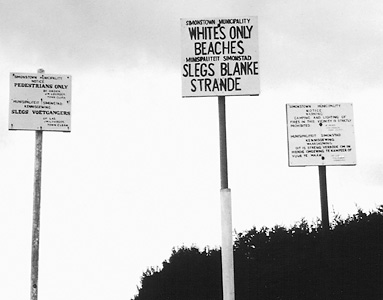Apartheid, << ah PAHRT hayt or ah PAHRT hyt >>, was, from 1948 until 1991, the South African government’s policy of rigid racial segregation. The word apartheid means separateness in Afrikaans, one of South Africa’s official languages.

Built on earlier South African laws and customs, apartheid classified every South African by race as either (1) Black, (2) white, (3) Coloured (mixed race), or (4) Asian. Apartheid required segregation in housing, education, employment, public accommodations, and transportation. It segregated not only almost all white people from nonwhite people, but also major groups of nonwhite people from each other. It also limited the rights of nonwhite people to own and occupy land, and to enter white neighborhoods.
The South African government tried to justify apartheid by claiming that peaceful coexistence of the races was possible only if the races were separated from one another. However, white South Africans used apartheid chiefly as a way to control the vast nonwhite majority.
Most South Africans strongly opposed apartheid. Leading opposition groups included the African National Congress (ANC). Most ANC members were Black. From 1948 to 1991, large numbers of people protested apartheid by staging boycotts, demonstrations, and strikes. Violence often broke out, and thousands of people, most of them Black, were killed.

Many countries also opposed apartheid. As a result, South Africa grew increasingly isolated in the world community. In 1962, the United Nations General Assembly urged its members to break diplomatic and economic ties with South Africa until apartheid was abolished. During the 1980’s, a widespread economic boycott of South Africa took hold. In response to domestic and international pressure, South Africa began repealing apartheid laws in the 1970’s and 1980’s. In 1990 and 1991, the government repealed most of the remaining laws that had formed the legal basis of apartheid.
But apartheid’s effects continued even after the laws were repealed. Today, many Black people and other nonwhite people continue to face unofficial segregation and discrimination in South Africa.
